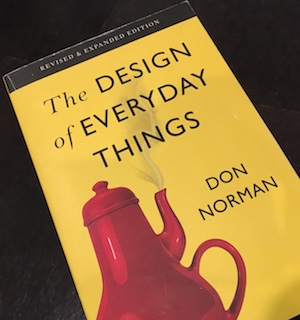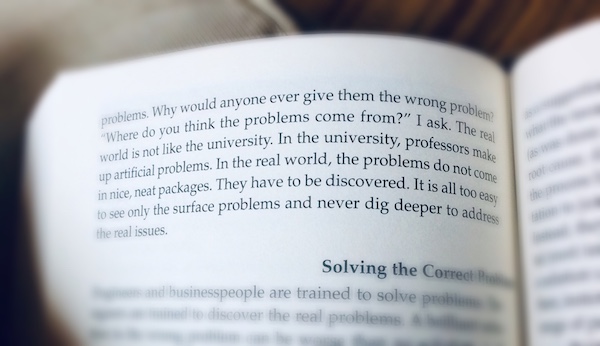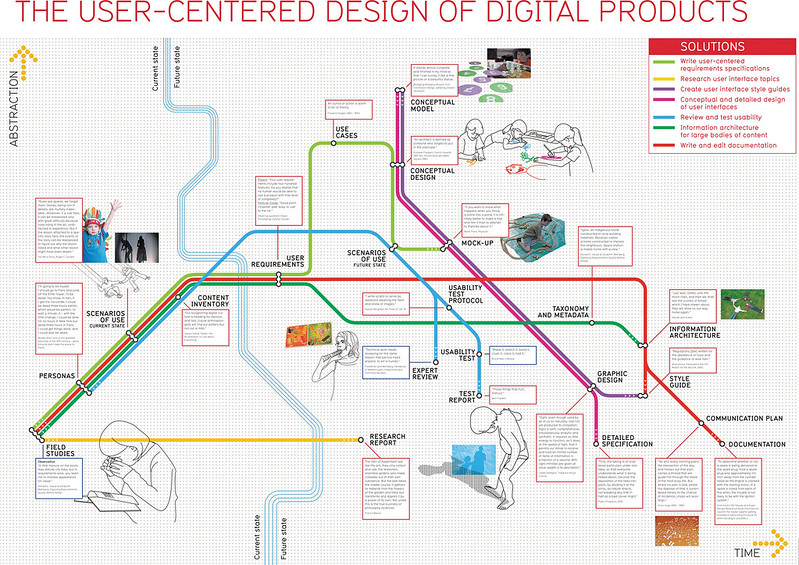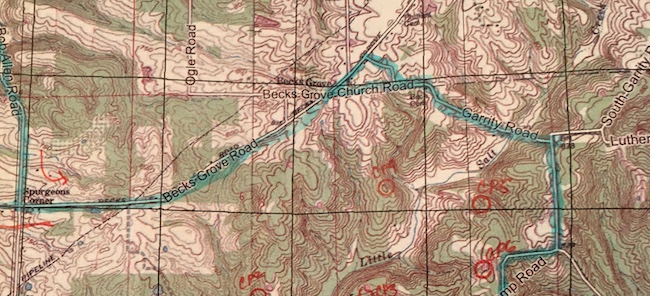November 24, 2018
Multiple industries are poised for new intersections, and resulting complexity, as digital and physical paths merge. We now have the near instant communication of devices (IoT), advanced pattern recognition and automated inference (AI), and on-demand manufacturing (3d printing). What the field of design offers can be essential to managing that complexity. This post is a guide and a record of the checkpoints that were helpful to me.
Initial Survey
My journey to design started with Don Norman’s “The Design of Everyday Things,” after hearing the term “Norman Doors.” A Norman Door is a door that requires instructions to be used properly. In his 2013 second edition, Don Norman suggests putting “Norman Doors” with quotes into your favorite image search engine.

If you find the book sitting unopened for more than a few days, perhaps skip to the chapter on Design Thinking, which is on page 217 in my edition.

A few months later, my team recommended the book “Lean UX,” written by Jeff Gothelf. Jeff’s second chapter on “Vision, Framing, and Outcomes” contains a great section on hypothesis creation, which can stand alone. (If you use the material on personas in this chapter, also accompany it with a view of Sian Townsend’s presentation on Jobs to be Done. The assumptions section in this chapter is best served with this excerpt on stakeholder interviewing from Kim Goodwin’s referential tome “Designing for the Digital Age: How to Create Human Centered Products and Services.”)

Forging a Path
It was only after hiring a designer to our team, that I became aware of how LARGE my design blindspot was. A design deficiency can’t be compensated for through clever improvisation. You must do the work to understand the richness of what is available, sampling a little bit from as wide an array of sources as possible. The book “The User Experience Team of One: A Research and Design Survival Guide,” written by Leah Buley, does this well. You can view the book’s illustrations to get a feel for its content on Rosenfeld Media’s flickr alubm. For a person who was new to the field, illustrations UXT016, UXT017, and UXT018 were eye opening for me.
Leah gives an important bit of advice that I couldn’t agree more with. In a framed sidebar titled “If You Only Do One Thing…” she suggests that people “focus on getting started with user research.” The book that helped me do that better than any other is “Interviewing Users: How to Uncover Compelling Insights” written by Steve Portigal. From framing the work, to execution, skill development, and tool selection, this book provides a starting point to orient oneself at any stage of interview based research.

Speaking of “tool selection,” one tool that has changed how I work is the Neo smartpen. The pen allows you to
- write on [special] paper,
- record your writing digitally,
- record voice on your phone, and
- synchronizes the audio and notes for future recall.
Using a pen instead of a laptop for notes removes the barrier of a screen which a participant can’t observe during the interview. I have found (anecdotally) that this allows me to connect more easily with the subject and is less distracting, while still providing digital search and processing capability after the interview is over.

Design Geology
At some point you may look at the terrain and ask, “how did that get there?” The design thinking story told by Jo Szczepanska is my favorite overview: “Design thinking origin story plus some of the people who made it all happen.” Jo designed what would have been a dauntingly long review to be digestible, fun, and people focused.
If you prefer your time travel to be more immersive, then head over to the Design Quarterly archives hosted by the Walker Art Center. I became aware of this collection because of Jessica Ivan’s UX Resources for Beginners post, where she added a reference to the 1989 issue “Hats,” which was an enjoyable read, and re-read.

Future Directions
I’m interested in how design is (and isn’t) affecting larger organizations. We are witnessing a change in how many companies use design to deal with ever greater complexity. You can see the evidence in increased hiring of designers and design firm acquisitions as documented in this 2017 techcrunch.com article. Forbes magazine pointed out a few years ago already that the role of “Chief Design Officer” is becoming more common. Recently Art + marketing observed how design can help anticipate change, and that with the emergence of new technologies consulting firms must acquire design expertise to compete.
Phil Gilbert, IBM Head of Design, gave a long and fantastic interview to High Resolution, a video series about design, about how he scaled design at IBM. Phil’s interview highlights a full commitment to embracing design methods as a complex problem identification and solving foundation.
In this domain I can recommend the following titles as guides for how to apply design and design thinking to organizational challenges:
- Strategic Design - a wonderful book filled with case studies and examples of how to discover context and evidence
- Change by Design - Tim Brown’s excellent book about problem identification, collaboration, and solution innovation
- Innovation by Design written by Edgar Papke and Thomas Lockwood offers detail and evidence for designing corporate cultures that support innovation
Of course, not everything can be learned from a book. You must go out and do the work of incorporating research and design into your work. Please share your work and experiences, so that we all can learn from one another.

